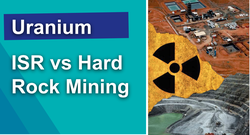Our Uranium Portfolio
| Stocks |
Date of Initial Coverage
|
Initial Entry Price
|
Highest Point |
Performance from Initial Entry
|
|---|---|---|---|---|
| HAR | 1695736800 27-Sep-2023 | $0.110 | 159% | -5% |
| GUE | 1676811600 20-Feb-2023 | $0.150 | 37% | -27% |
| AKN | 1643893200 04-Feb-2022 | $0.165 | -12% | -88% |
| GTR | 1588082400 29-Apr-2020 | $0.018 | 28% | -72% |
| Stocks |
Date of Initial Coverage
|
Initial Entry Price
|
Highest Point |
Performance from Initial Entry
|
|---|---|---|---|---|
| HAR | 1695736800 27-Sep-2023 | $0.110 | 159% | -5% |
| GUE | 1676811600 20-Feb-2023 | $0.150 | 37% | -27% |
| AKN | 1643893200 04-Feb-2022 | $0.165 | -12% | -88% |
| GTR | 1588082400 29-Apr-2020 | $0.018 | 28% | -72% |
How to invest in uranium
Macro Outlook Uranium - 2023
For the past couple of years, uranium has been among commodities that have modestly been on the up, and tipped for a further break-out that hasn’t yet materialised.
We think that a turn-around for uranium is on the horizon, and that companies with good uranium projects will prosper as a result.
With nuclear energy being another option for many countries’ coveted energy security goals, we think it will have a good year in 2023.
There are some factors that should have a positive impact on the uranium industry in 2023:
- Global energy transition to reduce fossil fuels reliance: Climate change is at the forefront of policy for governments across the globe, as they recognise the need to transition away from fossil fuel and lower carbon emissions. This requires more non-hydrocarbon sources of base load power.
- Reliable Power: Renewables such as wind and solar cannot deliver reliable base-load power for large economies. That leaves nuclear as the only non fossil-fuel sourced, base-load power option for countries without access to hydroelectricity. Consequently, the next decade should see the planning, building and reopening of several nuclear plants across the globe, meaning greater demand for uranium.
- Market Dynamics: When demand outstrips supply, prices inevitably rise. For uranium, some 200M lbs was consumed last year, compared to production of ~135M lbs and secondary supply of ~15M lbs (i.e. drawing down existing stockpiles). Funds such as Sprott Physical Uranium Trust have been purchasing physical uranium with a view to selling it back when the forecast supply crunch arises, so we can anticipate a rising uranium price in the short and medium term.
- Political Headwinds: Economies in Asia have announced plans to ramp up nuclear power activity as part of the energy mix. South Korea says a third of its energy production in 2030 will be through nuclear power and Japan is restarting many of its mothballed reactors following the post-Fukushima hiatus.
What the analysts say
Citi - has upgraded its uranium price outlook to reflect "overwhelming" long-term optimism. Noting a 40M lb supply shortfall in 2021 that continued into 2022, Citi has lifted its commodity price target for uranium this year, citing “overwhelming optimism” in the mid-to-near-term market.
Sprott - having their own vehicle to snap up and hoard physical uranium, it’s no surprise that Sprott is bullish on uranium. Sprott pointed to a shift away from Russian enrichment and supply, as well as energy shortages across the globe as further support for their sentiment.
Bear case
- Even allowing for the growing demand for nuclear power, the market price for uranium remains below the average cost of production. This is likely because of the overhang of uranium stockpiles that remain from the last bull run, with lingering aftershocks heralded from the Fukushima 2011 fall-out - however, these supplies are dwindling fast.
- A disaster at a nuclear facility (say in the Ukraine following an attack) could highlight the risks of nuclear as an energy source, and again deflate public, political and consumer sentiment for nuclear for several years.
- The AISC (All In Sustaining Cost) cost of production for larger uranium suppliers is within the US$60 to US$70/ lb range. What this means is that the price of uranium will firstly have to breach US$60 just to make certain that existing mines continue to operate, yet alone look to increase capacity. Until that happens, new mining supply is unlikely to come on stream.
- The current spot price remains under US$40/lb - that is, there is still some way to go before the current producers will look to ramp up supply, even despite the growing demand.
- We’d expect that new projects, and new mines, will likely require a uranium price well over US$70/lb to incentivise the large CAPEX required. That is still substantially above current spot prices, and so there is a way to go before this arises. There is no guarantee that this will occur, even with growing demand.
Our Uranium Investments

Haranga Resources (ASX:HAR)
Read Investment Memo →

Global Uraniuum and Enrichment (ASX:GUE)
Read Investment Memo →

Auking Minerals (ASX:AKN)
Read Investment Memo →

GTi Resources (ASX:GTR)
Read Investment Memo →



Our Commentary on Uranium
What Happened? Is The Small cap market back?
Weekender
Mar 9, 2024
|Next Investors
|16 min
Small cap market is back? What happened at the PDAC conference in Canada?
Signs of life in the small cap market
Weekender
Feb 24, 2024
|Next Investors
|8 min
In this week's trading sessions, we noticed many long ignored stocks in our portfolio and on our watchlist were seeing little nibbles of buying.
Surfing the commodities cycles
Weekender
Jan 27, 2024
|Next Investors
|15 min
Anyone who has been in the small cap markets for over 10 years has seen multiple commodity bull cycles. Iron ore, gold, lithium, uranium, nickel are examples of recent or current bull cycles.
What Happened? Is The Small cap market back?
Next Investors
|Mar 9, 2024
Signs of life in the small cap market
Next Investors
|Feb 24, 2024
Surfing the commodities cycles
Next Investors
|Jan 27, 2024